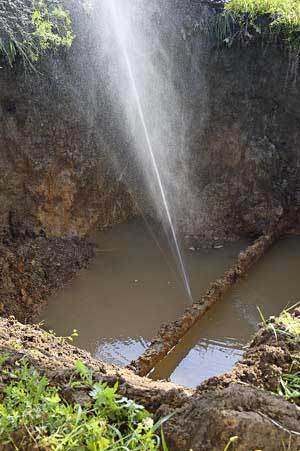Why are water leaks under the slab foundation bad?

- water leaks never get better, only worse, and can cause foundation problems
- water that pools under the home or building foundation will compact the soil causing it to settle; if the area of soil settlement become too large then the concrete slab could crack or settle also, creating a depression
- larger water leaks can saturate clay soils underneath a slab foundation causing the clay soils to swell and create a hump in the slab foundation
Warning Signs of Outgoing Water Leaks
- water seeping up through a bathroom or kitchen floor
- discoloration of wood or other floor coverings
- bad odors seeping through to the house
- a consistently wet area of the foundation
- foundation cracks / exterior wall cracks near bathrooms and kitchens
- an area outside the building perimeter that is consistently wet
*Remember, outgoing water lines are NOT under pressure – they use gravity to move the waste water to the city’s main sewer line.
Warning Signs of Incoming Water Leaks
- sudden increase in water usage (gallons)
- sound of water flowing through pipes when there is no water user
- sound of water flowing near the toilet (usually a toilet flapper problem)
- large wet spot in the grass or yard between the water main and the house or building
- large wet spots in the inner or outer building walls that follow the incoming water line
*Remember, incoming water lines are under pressure and any leak usually becomes obvious very quickly because the water is spraying out of a pipe.
What is a Hydrostatic Test ?
A hydrostatic test is a very simple test. The goal of the test is to determine if there is leak anywhere in the drain or sewer lines. The plumber will find the cleanout opening in the main drain line leaving the building perimeter and leading to the city’s main sewer line. He will plug this line with an inflatable rubber ball. Next he will start filling the drain and sewer lines under the slab foundation with water. Once he fills all of the under slab plumbing lines to floor level he will wait approximately 15 minutes to see if the water level in the drain lines drops. If the water level does not drop then there is no leak. If it does drop then there is a leak somewhere and an isolation test will be necessary to find the location of the leak(s). The plumber will then remove the inflatable rubber ball and close the cleanout exit.
What is an Isolation Test ?
Once a hydrostatic test determines there is a leak present in the under slab plumbing system, the next step is to find the exact location with an isolation test. The plumber will “section off” or isolate portions of the drainage system and test each one individually. He will employ the same strategy as used in the hydrostatic test except he is testing one bathroom or kitchen or utility room at a time. He will test all sections of the under slab plumbing system, one at a time. A small camera attached to a cable can be used to identify the exact spot of the leak.
Camera Inspection
A plumber may choose to use a camera to inspect a drain line. The camera is attached to a cable and fed into the drain lines. Cameras are very helpful in locating the exact problem area because a special transmitter will help an above ground assistant pinpoint the spot. Cameras can also record a video of the drain lines for future use. Camera are also used by plumbers to make a complete diagram of the waste water sewage system. Cameras are useful tools for plumbers and help them make more accurate repair and cost estimates for the waste water system.
Cost of Hydrostatic / Isolation Plumbing Tests
Residential
$275 to $350 first 2 hours; then $125 to $150 per additional hour
Commercial
$450 first 2 hours; then $200 per additional hour
